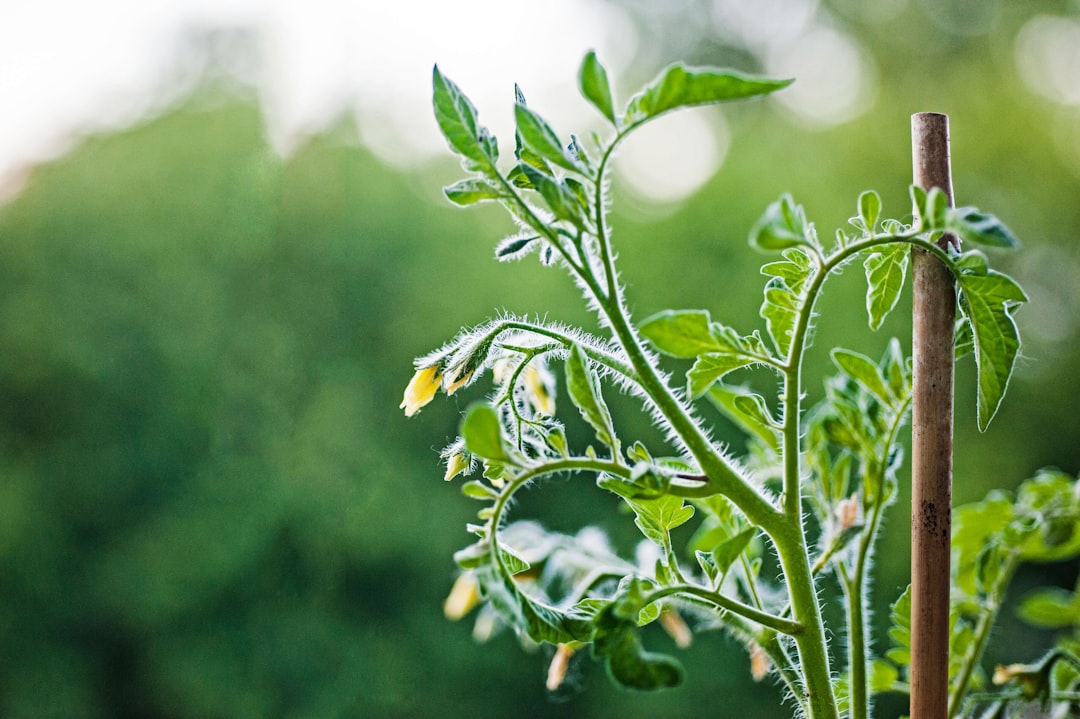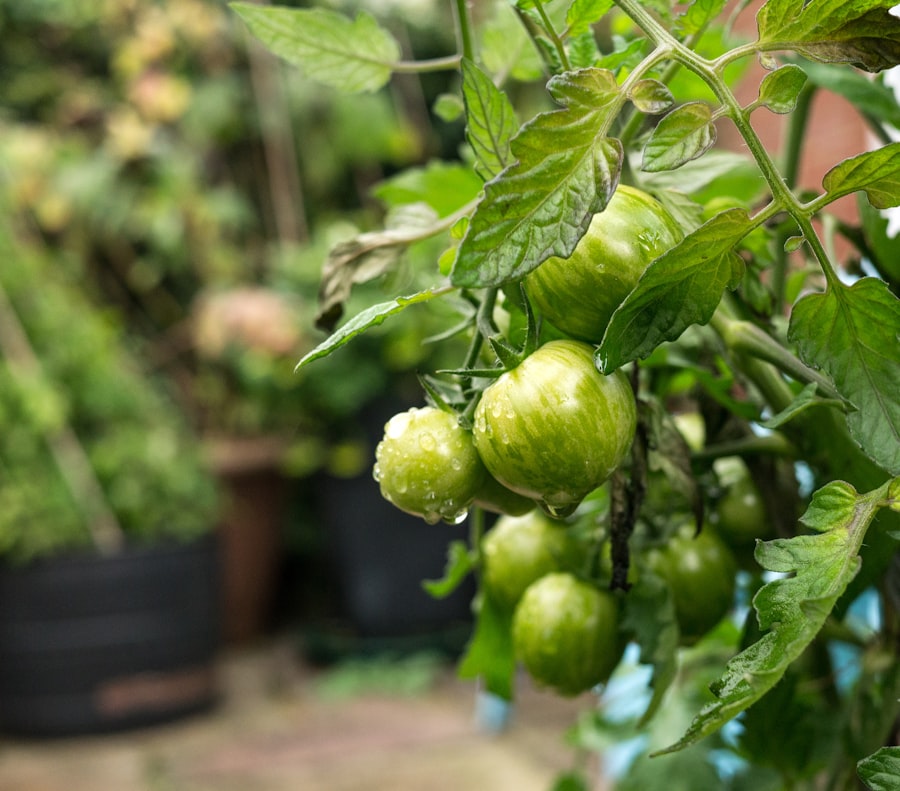Yellow Leaves on Tomato Plants: Causes and Solutions

Tomato plants are a popular choice for home gardeners due to their delicious fruit and relatively easy cultivation. However, one common issue that many gardeners face is the appearance of yellow leaves on their tomato plants. Yellow leaves can be a sign of various problems, including nutrient deficiencies, watering issues, pests and diseases, and environmental factors. It is important to identify and address the root cause of yellow leaves in order to maintain the health and productivity of tomato plants.
Identifying and addressing yellow leaves on tomato plants is crucial for several reasons. Firstly, yellow leaves can be an indication of a problem that, if left untreated, can lead to the decline and eventual death of the plant. By identifying the cause of yellowing leaves early on, gardeners can take appropriate action to rectify the issue and save their plants. Secondly, healthy tomato plants with vibrant green leaves are more likely to produce abundant and high-quality fruit. Addressing yellow leaves can therefore improve the overall yield and quality of the harvest.
Common Causes of Yellow Leaves on Tomato Plants
There are several factors that can cause yellowing of leaves on tomato plants. It is important to identify the root cause in order to effectively address the issue. One common cause is nutrient deficiencies. Tomato plants require a balanced supply of nutrients in order to thrive, and deficiencies in certain nutrients can lead to yellowing of leaves. Another common cause is watering issues, such as overwatering or underwatering. Improper watering practices can disrupt the uptake of nutrients by the plant, leading to yellow leaves.
Pests and diseases can also cause yellowing of leaves on tomato plants. Common pests that attack tomato plants include aphids, whiteflies, and spider mites. These pests feed on the sap of the plant, causing damage that can result in yellowing leaves. Similarly, diseases such as early blight and septoria leaf spot can cause yellowing and browning of leaves. Finally, environmental factors such as temperature and sunlight can contribute to yellowing of leaves. Extreme temperatures or insufficient sunlight can stress the plant and lead to yellowing.
Nutrient Deficiencies as a Cause of Yellow Leaves on Tomato Plants
Nutrient deficiencies can cause yellowing of leaves on tomato plants. Tomato plants require a range of nutrients in order to grow and produce fruit. Deficiencies in certain nutrients can result in yellowing leaves and stunted growth. The most common nutrient deficiencies in tomato plants are nitrogen, phosphorus, potassium, magnesium, and iron.
A nitrogen deficiency is often characterized by pale yellow leaves that start at the bottom of the plant and gradually move upwards. The leaves may also appear stunted and have a general lack of vigor. Phosphorus deficiency, on the other hand, is characterized by dark green leaves with a purplish tint. The leaves may also have a leathery texture and show signs of curling. Potassium deficiency can cause yellowing and browning of leaf edges, as well as poor fruit development.
Magnesium deficiency is characterized by interveinal chlorosis, which means that the veins of the leaves remain green while the areas between them turn yellow. This can give the leaves a marbled appearance. Iron deficiency, also known as iron chlorosis, causes yellowing of the leaves while the veins remain green. The affected leaves may also show signs of necrosis or tissue death.
Watering Issues and Yellow Leaves on Tomato Plants
| Watering Frequency | Yellow Leaves | Plant Health |
|---|---|---|
| Overwatering | Yes | Poor |
| Underwatering | Yes | Poor |
| Proper Watering | No | Healthy |
Watering issues can contribute to yellowing of leaves on tomato plants. Overwatering or underwatering can disrupt the uptake of nutrients by the plant, leading to yellow leaves. Overwatering can cause root rot, which prevents the roots from absorbing nutrients effectively. This can result in yellowing and wilting of leaves.
On the other hand, underwatering can cause the plant to become stressed and unable to take up nutrients properly. This can also lead to yellowing of leaves. It is important to strike a balance when watering tomato plants. The soil should be moist but not waterlogged, and the plants should be watered deeply and infrequently rather than shallowly and frequently.
To ensure proper watering, it is recommended to water tomato plants deeply once or twice a week, depending on the weather conditions. The soil should be allowed to dry out slightly between waterings, but not to the point of wilting. Mulching around the base of the plants can help retain moisture in the soil and prevent evaporation.
Pests and Diseases as Causes of Yellow Leaves on Tomato Plants
Pests and diseases can cause yellowing of leaves on tomato plants. Common pests that attack tomato plants include aphids, whiteflies, and spider mites. These pests feed on the sap of the plant, causing damage that can result in yellowing leaves. Aphids are small insects that suck the sap from the leaves, causing them to curl and turn yellow. Whiteflies are tiny white insects that feed on the undersides of leaves, causing them to turn yellow and eventually die. Spider mites are tiny arachnids that feed on the leaves, causing yellowing and stippling.
Diseases such as early blight and septoria leaf spot can also cause yellowing of leaves on tomato plants. Early blight is a fungal disease that causes dark brown spots with concentric rings on the leaves. As the disease progresses, the spots enlarge and turn yellow, eventually leading to defoliation. Septoria leaf spot is another fungal disease that causes small brown spots with black specks on the leaves. The spots may have a yellow halo around them, and as they enlarge, the leaves turn yellow and die.
To control pests, it is important to regularly inspect tomato plants for signs of infestation and take appropriate action. This may include manually removing pests, using insecticidal soap or neem oil, or introducing beneficial insects such as ladybugs or lacewings. To control diseases, it is important to practice good sanitation by removing and disposing of infected leaves and avoiding overhead watering, which can spread fungal spores. Fungicides may also be used as a last resort.
Environmental Factors Contributing to Yellow Leaves on Tomato Plants

Environmental factors such as temperature and sunlight can contribute to yellowing of leaves on tomato plants. Extreme temperatures, whether too hot or too cold, can stress the plant and lead to yellowing of leaves. High temperatures can cause the plant to transpire more water than it can take up, resulting in wilting and yellowing of leaves. On the other hand, cold temperatures can slow down the metabolic processes of the plant, leading to nutrient deficiencies and yellowing of leaves.
Insufficient sunlight can also cause yellowing of leaves on tomato plants. Tomato plants require at least six hours of direct sunlight per day in order to grow and produce fruit. If they do not receive enough sunlight, they may become weak and pale, with yellowing leaves. It is important to choose a sunny location for tomato plants and provide them with adequate sunlight throughout the day.
To manage environmental factors and prevent yellowing of leaves, it is important to provide proper care and maintenance for tomato plants. This includes choosing a suitable location with adequate sunlight, protecting the plants from extreme temperatures with shade cloth or row covers, and providing consistent watering to prevent drought stress.
Identifying the Type of Yellowing on Tomato Plants
It is important to accurately identify the type of yellowing on tomato plants in order to provide proper treatment. There are several different types of yellowing that can occur, each with its own underlying cause. Chlorosis refers to a general yellowing of the entire leaf, while interveinal chlorosis refers to yellowing between the veins of the leaf. Necrosis refers to tissue death, which can appear as brown or black spots on the leaves.
Chlorosis can be caused by nutrient deficiencies, watering issues, pests and diseases, or environmental factors. Interveinal chlorosis is often a sign of magnesium or iron deficiency. Necrosis can be caused by diseases such as early blight or septoria leaf spot, as well as environmental factors such as extreme temperatures or sunburn.
Accurately identifying the type of yellowing is important because it can help determine the appropriate treatment. For example, if the yellowing is due to a nutrient deficiency, applying a fertilizer that is specifically formulated for tomato plants can help correct the issue. If the yellowing is due to a pest infestation, using an appropriate insecticide or introducing beneficial insects can help control the pests.
Preventative Measures to Avoid Yellow Leaves on Tomato Plants
Preventing yellowing of leaves on tomato plants is always better than trying to treat the issue once it has occurred. There are several preventative measures that gardeners can take to avoid yellow leaves and maintain the health of their tomato plants. Firstly, it is important to choose healthy and disease-resistant varieties of tomato plants. This can help prevent issues such as pests and diseases that can cause yellowing of leaves.
Proper care and maintenance are also crucial for preventing yellow leaves. This includes providing adequate sunlight, proper watering, and regular fertilization. Tomato plants should be watered deeply and infrequently, allowing the soil to dry out slightly between waterings. Fertilizer should be applied according to the specific needs of tomato plants, taking into account their nutrient requirements.
Good sanitation practices can also help prevent yellowing of leaves. This includes removing and disposing of infected leaves or plants, practicing crop rotation to prevent the buildup of pests and diseases in the soil, and keeping the garden clean and free of debris.
Treating Yellow Leaves on Tomato Plants with Natural Remedies
Natural remedies can be effective in treating yellowing of leaves on tomato plants. These remedies are safe and environmentally friendly, making them a popular choice for organic gardeners. One common natural remedy is the use of compost or organic matter to improve soil fertility and nutrient availability. Adding compost to the soil can help replenish nutrients and improve the overall health of tomato plants.
Another natural remedy is the use of foliar sprays made from ingredients such as seaweed extract or fish emulsion. These sprays can provide a quick boost of nutrients to the plants and help alleviate nutrient deficiencies that may be causing yellowing of leaves. Epsom salt, which is rich in magnesium, can also be used as a foliar spray to correct magnesium deficiency.
In addition to these remedies, it is important to provide proper care and maintenance for tomato plants. This includes regular watering, proper fertilization, and good sanitation practices. By providing the necessary care, tomato plants can recover from yellowing leaves and regain their health and vigor.
Maintaining Healthy Tomato Plants with Proper Care and Maintenance
In conclusion, yellow leaves on tomato plants can be a sign of various problems, including nutrient deficiencies, watering issues, pests and diseases, and environmental factors. It is important to identify and address the root cause of yellow leaves in order to maintain the health and productivity of tomato plants. Nutrient deficiencies can be corrected through proper fertilization, while watering issues can be resolved by providing consistent and appropriate watering. Pests and diseases can be controlled through regular inspection and appropriate treatment. Environmental factors can be managed through proper care and maintenance.
By providing proper care and maintenance for tomato plants, gardeners can prevent yellowing of leaves and maintain the health and productivity of their plants. This includes choosing healthy varieties, providing adequate sunlight, proper watering, and regular fertilization. Good sanitation practices and the use of natural remedies can also help prevent and treat yellowing of leaves. By taking these steps, gardeners can enjoy a bountiful harvest of healthy and delicious tomatoes.



